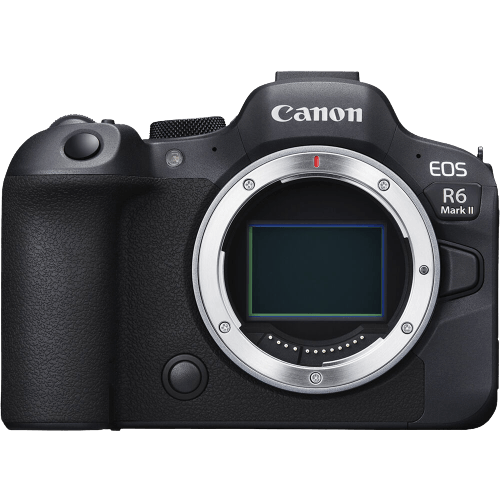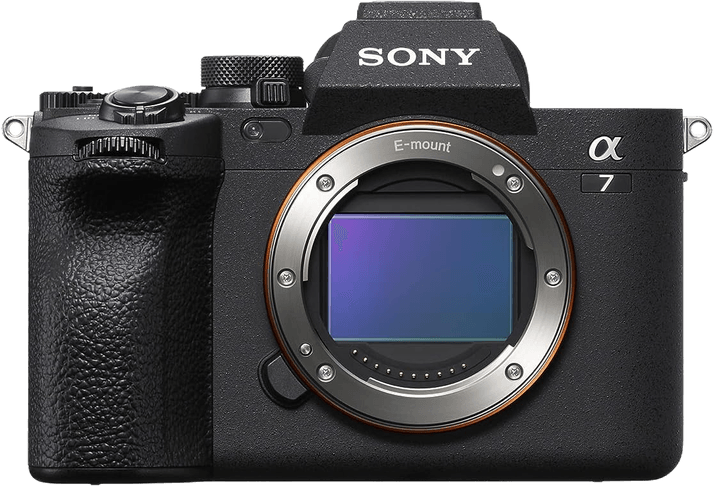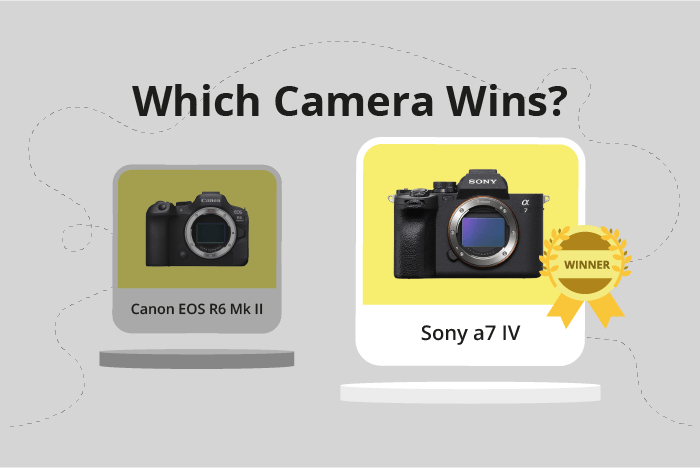Canon EOS R6 Mark II vs Sony a7 IV Comparison
Canon EOS R6 Mark II

Sony a7 IV

The Sony a7 IV takes the lead with a score of 84/100, while the Canon EOS R6 Mark II trails by 6 points at 78/100. Both cameras share similarities as mirrorless models, released in 2021 and 2022, and priced at $2499. They also have comparable dimensions, with the Canon being slightly larger at 138.4 x 98.4 x 88.4mm and the Sony at 131 x 96 x 80mm.
The Sony a7 IV’s advantage lies in its higher score, reflecting its superior performance and quality. On the other hand, the Canon EOS R6 Mark II is lighter at 588g, compared to the Sony’s 659g, offering a more comfortable shooting experience.
Taking into account the specifications and performance, the Sony a7 IV stands out as the better camera. However, the Canon EOS R6 Mark II’s lighter weight may appeal to some users who prioritize portability and ease of use.
Canon EOS R6 Mark II vs Sony a7 IV Overview and Optics
The Sony a7 IV wins the optics comparison with a score of 85/100, while the Canon EOS R6 Mark II scores 83/100. Both cameras share some similarities in their specifications, including a CMOS sensor, full-frame sensor size, and image stabilization. Additionally, they both have their respective lens mounts, with the Canon using the RF mount and the Sony using the FE mount.
The Sony a7 IV performs better in terms of megapixels and sensor quality, boasting 33 megapixels and a DXOMARK score of 97 for its sensor, compared to the Canon’s 24 megapixels and DXOMARK score of 91. The higher megapixel count and sensor score translate to better image quality and detail, making the Sony a7 IV a superior choice for photographers seeking optimal image resolution.
On the other hand, the Canon EOS R6 Mark II excels in shooting speed, offering a remarkable 40 shots per second, while the Sony a7 IV only manages 10 shots per second. This advantage makes the Canon EOS R6 Mark II more suitable for capturing fast-moving subjects and action photography.
In conclusion, the Sony a7 IV outperforms the Canon EOS R6 Mark II in terms of image quality and sensor performance, making it the preferred option for photographers who prioritize resolution and detail. However, the Canon EOS R6 Mark II’s superior shooting speed makes it a strong contender for those who require rapid capture capabilities. Ultimately, the choice between these two cameras depends on the specific needs and priorities of the photographer.
Canon EOS R6 Mark II vs Sony a7 IV Video Performance
The Sony a7 IV outperforms the Canon EOS R6 Mark II in video capabilities, with a video score of 91/100 compared to the Canon’s 83/100. Both cameras share some common video specifications, such as 4K max video resolution and 3840 x 2160 max video dimensions. Additionally, both cameras have built-in time-lapse functionality.
The Sony a7 IV surpasses the Canon EOS R6 Mark II in several aspects. Firstly, the a7 IV offers a higher max video frame rate of 120fps, compared to the 60fps of the Canon R6 Mark II. This allows for smoother slow-motion footage and more creative options for videographers. The higher video score of the Sony a7 IV also suggests better overall video quality, making it the superior option for those focused on videography.
On the other hand, the Canon EOS R6 Mark II still provides solid video performance with its 4K max video resolution and 60fps max video frame rate. Although it falls short in comparison to the Sony a7 IV, the Canon R6 Mark II remains a viable option for casual video shooters or photographers who occasionally dabble in videography.
When comparing the video capabilities of these two cameras, the Sony a7 IV emerges as the clear winner due to its higher video score and superior max video frame rate. While the Canon EOS R6 Mark II offers decent video performance, those seeking the best video quality and features should opt for the Sony a7 IV.
Canon EOS R6 Mark II vs Sony a7 IV Features and Benefits
The Sony a7 IV emerges as the winner in this comparison, scoring 83/100, while the Canon EOS R6 Mark II trails behind with a score of 72/100. Both cameras share several features, including a 3-inch touchscreen, flip screen, WIFI, and Bluetooth capabilities.
The Sony a7 IV outperforms the Canon EOS R6 Mark II in terms of screen resolution, offering 1,040,000 dots compared to the Canon’s 1,620,000 dots. This higher resolution provides the Sony a7 IV with a clearer and sharper display, enhancing the user’s experience while composing and reviewing images. Additionally, the Sony a7 IV possesses GPS functionality, which the Canon EOS R6 Mark II lacks. This feature allows users to geotag their images, making it easier to track and organize photos based on location.
On the other hand, the Canon EOS R6 Mark II has a higher feature score, but it does not necessarily make it a better camera. Its additional features may not be as relevant or important to some users, depending on their specific needs and preferences.
In comparing these two cameras, it is clear that the Sony a7 IV offers a superior screen resolution and GPS capabilities. Meanwhile, the Canon EOS R6 Mark II’s higher feature score may not necessarily translate to a better camera for all users. When making a decision between these two cameras, potential buyers should consider their individual needs, preferences, and the importance of each feature to determine which camera best suits their requirements.
Canon EOS R6 Mark II vs Sony a7 IV Storage and Battery
The Sony a7 IV outperforms the Canon EOS R6 Mark II in storage and battery with a score of 76/100 compared to the Canon’s 68/100. Both cameras share common specifications, including two memory card slots and USB charging capability. However, the Sony a7 IV surpasses the Canon EOS R6 Mark II in certain aspects.
The Sony a7 IV offers longer battery life, providing 580 shots per charge compared to the Canon’s 360 shots. Additionally, the Sony a7 IV accepts both CFexpress Type A and SD (UHS-II compatible) memory cards, offering more flexibility in storage options. On the other hand, the Canon EOS R6 Mark II only accepts SD / SDHC / SDXC (UHS-II compatible) memory cards.
Despite its lower score, the Canon EOS R6 Mark II still offers reliable storage and battery performance with its LP-E6NH battery type and compatibility with widely available SD / SDHC / SDXC (UHS-II compatible) memory cards.
The Sony a7 IV proves to be the superior choice in terms of storage and battery life, making it ideal for photographers requiring extended shooting sessions and versatile storage options. The Canon EOS R6 Mark II remains a solid option for those who prioritize SD card compatibility and are satisfied with its battery performance.
Canon EOS R6 Mark II vs Sony a7 IV – Our Verdict
Are you still undecided about which camera is right for you? Have a look at these popular comparisons that feature the Canon EOS R6 Mark II or the Sony a7 IV:

